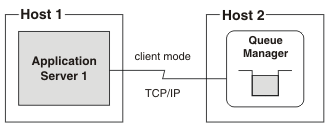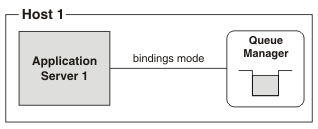Interoperation when WebSphere Application Server application server is not clustered and WebSphere MQ queue manager is not clustered
Application servers running on WebSphere Application Server and queue managers running on WebSphere MQ can connect to each other when neither of them are clustered. However, this setup can be vulnerable to failure.
In this topic "application server" refers to an application server running on WebSphere Application Server and "queue manager" refers to a queue manager running on WebSphere MQ.
There are two topology options:
- The application server and the queue manager run on different hosts
- The application server and the queue manager run on the same host
The application server and the queue manager run on different hosts
The WebSphere MQ transport type for the connection is specified as "client". A client connection is used when the application server and queue manager are running on different hosts. This is a TCP/IP network connection used to communicate with the queue manager. A client connection is also known as "socket attach".
The following figure shows an application server and a queue manager running on different hosts.
Figure 1. No clustering: client mode attachment to queue manager

This topology is vulnerable because inter-operation ceases if any of the following conditions occurs:
- The application server fails.
- The host on which the application server is running fails.
- The queue manager fails.
- The host on which the queue manager is running fails.
We can improve availability for this topology by using, for example, High Availability Cluster Multi-Processing HACMP™ to restart the failed component automatically.
The application server and the queue manager run on the same host
The transport type for the connection is specified as "bindings". A bindings connection is used when the application server and the queue manager are running on the same host. This is a cross-memory connection used to communicate with a queue manager. A bindings connection is also known as "call attach".
The following figure shows a application server and a queue manager running on the same host.
Figure 2. No clustering: bindings mode attachment to queue manager

The availability constraints for this topology are similar to the previous one. However, in some configurations bindings mode is faster and more processor efficient than client mode because the amount of processing is reduced.